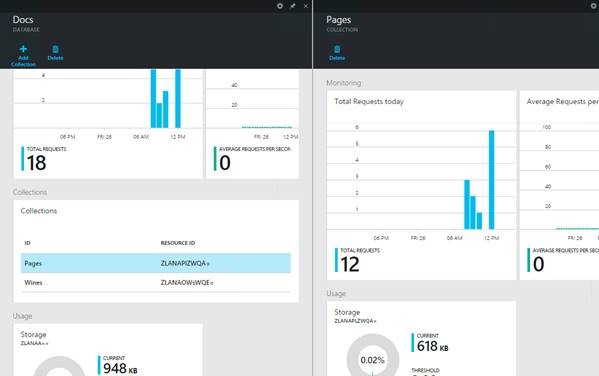Document Explorer, Collection management and new metrics
Document Explorer, Collection management and new metrics
We are continuing to improve the developer and management experiences so you can be more productive and build great applications on DocumentDB. Our October 2nd portal update lights up the following new experiences through https://portal.azure.com:
- Document Explorer – view and access JSON documents in your DocumentDB Account
- Collection management – easily add and delete Collections
- Database performance metrics and storage information – view performance metrics and storage consumed at a Database level
- Collection performance metrics and storage information – view performance metrics and storage consumed at a Collection level
- Support for Azure tags – apply custom tags to DocumentDB Accounts
Keep reading for some additional information on each of these new features!
Document Explorer
Near the bottom of the DocumentDB Account, Database, and Collection blades, you’ll find a new Developer Tools lens:
In this release, we’ve surfaced a read-only Document Explorer experience. Selecting a database and collection within the Document Explorer will allow you to view documents within that collection:
Note that the Document Explorer will load up to the first 100 documents in the selected Collection. You can load additional documents (in batches of 100) by selecting the “Load more” option at the bottom of the Document Explorer blade:
Note that future updates will expand Document Explorer functionality to enable document CRUD operations as well as the ability to filter documents.
Add Collection Functionality
The DocumentDB Database blade now allows you to quickly create a new Collection through the “Add Collection” command found on the top left of the Database blade:
Collection Blade
We’ve added a new Collection blade which exposes Collection level performance metrics and storage information. You can access this new blade by selecting a Collection from the list of Collections on the Database blade.
Database and Collection performance metrics
We’ve made Database and Collection level metrics available via the Database and Collection blades:
We’ve also added Database and Collection level storage usage information:
Support for Azure Tags
The Azure portal now supports applying tags to resources so that users can filter/group items as they see fit. We've enabled Tags support for DocumentDB Accounts via the Tags part in the Summary lens of the DocumentDB Account blade:
That’s it for this round of updates. We hope that the new features unlock greater visibility in to what is happening within your Account, Databases and Collections.
As always, we’d love to hear from you about the DocumentDB features and experiences you would find most valuable within the Azure portal. Please submit your suggestions on the Microsoft Azure DocumentDB feedback forum.
Enjoy!
Stephen Baron
Program Manager
Comments
Anonymous
October 09, 2014
All this Looks really nice ... I can't wait to evaluate it to see if it fits for my scenario as an alternative to my current SQL Server + Table Storage solution, but I'm still waiting for features like ORDER BY. In my case, I have a news reader app where a user can subscribe to different news sources and read their articles (= documents) in a descending order, either for a single source, or all of his subscribed sources or a set of his subscribed sources within some kind of "folder". Currently, I don't see a way that DocumentDB supports my required query scenarios, but I'm hopeful it will soon.Anonymous
October 21, 2014
@Bernhard, we understand that custom ORDER BY and is really important and we're hard at work to make sure this lands in the service as soon as possible.Anonymous
July 22, 2015
You can easily add and delete collections but adding a collection costs money and there is not a way to clear your connection with one command. So clearing means getting every document and deleting every document which is quite some computing. Do you have any remarks on this statement? I would like to know if there is a better solution. Kind regards, David







